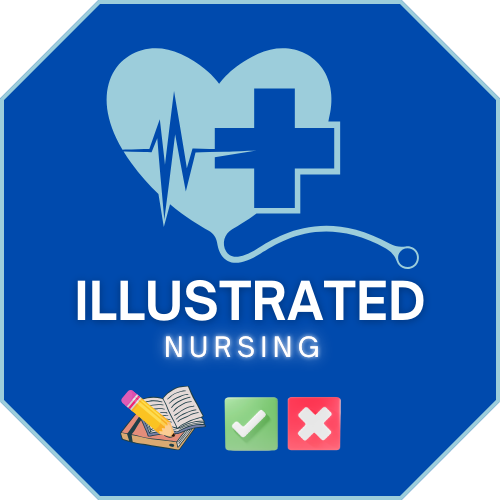Study commonly tested material using flashcards
Medications that end in -lol. ↓ BP & ↓ HR. Even with medications such as Timolol eye drops for glaucoma, teach client to check heart rate.
- Limit alcohol and caffeine
- Exercise 3x/week
- Limit sodium and fat intake
- Sodium < 2 g/day
- Weight loss
- Limit processed foods
- Use frozen foods instead of canned foods (canned high in sodium).
- Stop smoking
- Eat more fruits and vegetables
Elevate affected extremity to decrease swelling.
- Monitor vital signs
- Daily weights
- Monitor electrolytes
- Change tubing every 24 hours
- Use sterile technique
- Never stop TPN abruptly to prevent hypoglycemia!
- Priority is to report diminished pulse (or signs of decreased perfusion) on affected extremity.
- Skin integrity. Assess heels for redness and tenderness and relieve pressure.
- Anticoagulants such as heparin: check for bleeding (e.g., epistaxis or nosebleed).
- Warfarin: take at the same time every day.
- Sublingual used for chest pain/angina. Take 1 every 5 minutes. Works within 1 to 3 minutes. If no angina relief after 3 doses, call 911 (may be having an MI).
- Potassium affects the heart. Monitor for irregular heart rhythm. Priority is to connect to cardiac monitor to check rhythm.
Don’t forget to check for latex allergy.
Always feel the thrill and listen (auscultate) to the bruit.
Dysruria, nausea, nocturia, confusion, urgency, lower back discomfort, bladder cramping, hematuria, and pyruria (cloudy urine).
Never suction for more than 10 to 15 seconds. Provide oral care/suction secretions to maintain airway.
NPO x 6 to 8 hours and Stop NSAIDs/Aspirin per MD.
Left side
- HPV: give to teenage boys
- Immunosuppressed/chemotherapy: give inactive influenza
- MMR: do not give is allergic to gelatin.
- Pillow under head ok
- Never put anything in patient’s mouth but do monitor for oral injuries (clients may bite their tongue).
- Do not restrain patient
Pain in the right upper abdomen
- Hold feedings x 1 hour and check again if high residuals
- If abdominal cramping/nausea during intermittent feedings, slow rate of administration.
Monitor for hypocalcemia (Chvostek’s and Trousseau’s signs). Have tracheostomy kit at the bedside in case of airway closure.
Make sure they are below the level of the client’s chest
Everything is high except potassium: Hypernatremia, hyperglycemia, hypervolemia, high weight but HYPOKALEMIA. Client should limit sodium intake.
- Fruity Breath
- Fast, deep breathing (Kussmaul breathing)
- Dry skin and mouth (Think dehydration)
- Flushed face.
- Fruity-smelling breath.
- Headache.
- Muscle stiffness or aches.
- Being very tired.
- Nausea and vomiting.
- Polyuria
Low salt and low saturated fats.
Lateral recumbent during lumbar puncture and flat after lumbar puncture (to prevent headache).
Wash hands with warm water and soap for 20 seconds. #1 way to prevent infection.
- Daily clean socks
- cut toe nails straight scross
- leather shoes
- Clean/dry between toes
- No lotion between toes.
- STOP THE INFUSION is the priority action.
Avoid laying on the affected side
Measure abdominal girth.
- Contact people who live with the client to be tested/treated.
These clients are immunosuppresed. Think reverse/protective isolation. No live plants, no sick visitors, no live vaccines.
- Put on PPE before entering room
- Take off PPE (dirty PPE) before exiting the room. Think dirty PPE stays inside.
- Roll gown inside out for disposal.
- Remove dirty gloves before exiting room.
- Barrel chest
- Elevated Hemoglobin/hematocrit in response to hypoxia. The hgb can be as high as 20 (notify provider if places pt on high risk for stroke).
- Low dose oxygen. 2 to 3 L/NC or 28% venturi mask.
- Occurs after gastric surgery
- Lay down after eating or eat laying down. You want to slow digestion.
- Eat slow and chew food
- Eat more protein (digests slower): Poultry, red meat, fish, eggs, tofu, nuts, milk, yogurt, cheese, and peanut butter.
- Limit carbohydrates: bread, ice cream, sugars. Carbohydrates digest faster.
- Symptoms: Feeling bloated or too full after eating. Nausea. Vomiting. Abdominal cramps. Diarrhea. Flushing. Dizziness, lightheadedness. Rapid heart rate. Sweating.
Soft bland diet
- Monitor for aspiration
- If facial paralysis, place food on the strong side of the mouth.
Assess level of consciousness.
- Right= Rest of the body swelling. Splenomegaly, hepatomegaly, edema of lower extremities.
- To assess for pitting edema: presss firmly with fingertip on edematous areas.
- heart failure: Think volume excess.
- Think respiratory symptoms: orthopnea, dyspnea, pink frothy sputum.
- Candidiasis: White vaginal discharge
- Yeast Infection: Thick white cheesy
- Trichomoniasis: frothy yellow or greenish with bad smell.
- Bacterial vaginosis: White, gray, or yellow with fishy odor
- Gonorrhea: Cloudy or yellow
- Shedding of the uterine lining after childbirth (lochia): changes from red to pink to white.
Contact Precautions. Must wash hands with soap and water (Not sanitizer)
